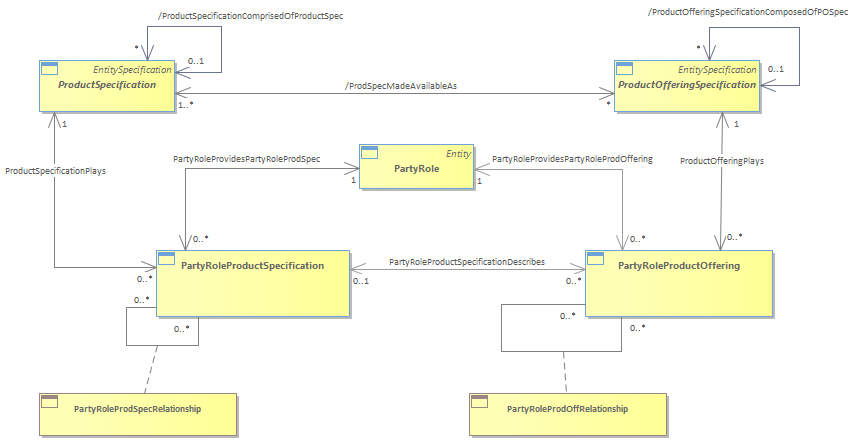Figure PPSO.03 - Party Role Product Offering and Product Specification

|
Project:
|

Figure PPSO.03 - Party Role Product Offering and Product Specification : Class diagram
<font color="#e0121d"><b>Example 1</b></font><br/><font color="#29313b">K&H is a vendor who offers the cat bed to Amazon so that Amazon can buy it and sell it. K&H sells it to Amazon for $20.</font><br/><font color="#29313b">K&H’s is a retailer whose cat bed is also for sale on the Amazon site as K&H’s offer. K&H sells it to the public for $25.</font><br/><font color="#29313b">So, the K&H cat bed Product Offering has two prices $20 and $25.</font><br/><font color="#29313b">The first option would include a PartyRoleProductOffering for K&H the vendor and another PartyRoleProductOffering for K&H the retailer that is related to the K&H cat bed ProductOffering. The relationship between PartyRoleProductOffering and ProductOfferingPrice provides a way to distinguish which price ($20 or $25) is charged to Amazon or to Amazon’s customers.</font><br/><font color="#29313b">The second option would include a cat bed ProductOffering for K&H the vendor and another one for K&H the retailer. The first ProductOffering carries the price of 20$ and is dedicated to Amazon, and the second one carries the price of 25$.</font><br/><font color="#29313b">One concern may be that if there is only one ProductOffering with the price related to PartyRoleProductOffering there is a need for two PartyRoleProductOfferings for Amazon. This is because the processes undertaken by Amazon might be different based on when they buy it from K&H and when they sell it on behalf of K&H). And same concern for K&H. With only one ProductOffering there is not a way to determine which price should be used. This is not the case since K&H plays two roles, one of vendor and one of retailer. Amazon would access the vendor PartyRoleProductOffering and the ProductOfferingPrice ($20) associated with it.</font><br/><font color="#e0121d"><b>Example 2</b></font><br/><font color="#29313b">An enterprise offers a WiFi enable thermostat and as part of a bundle offers an installation service ProductOffering. This ProductOffering can be provided by one or more other PartyRoles if a customer does not want to do a self-installation.</font><br/><font color="#29313b">Using the first option there is one ProductOffering, but each PartyRole that offers the installation service may charge different prices that are displayed on an enterprise’s web pages. In this case there would be PartyRoleProductOffering for each PartyRole that offers the installation service. Each PartyRoleProductOffering is related to a ProductOfferingPrice that represents a party’s installation price.</font><br/><font color="#29313b">Using the second option there is one ProductOffering and a related ProductOfferingPrice for each party that offers the installation service. Each ProductOffering would be included in the bundle and would have a “mutually exclusive” ProductOfferingRelationship among them.</font><br/>The following Figure shows the association between PartyRoleProductSpecification and PartyRoleProductOffering. The association is similar to that between ProductSpecification and ProductOffering. The association’s 0..1 multiplicity allows for offerings, such as BundledProductOfferings, to not have an associated specification.<br/>
|

